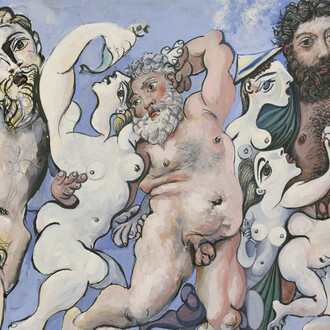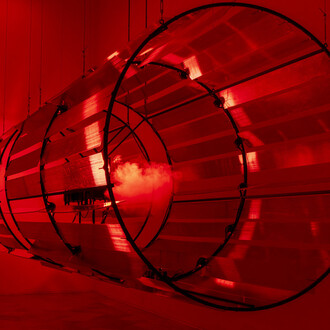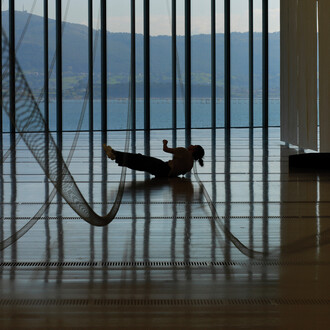The undeniable presence of death in the work of Jose Luis Valverde (Malaga, 1987) forces us to a careful re-exploration of the symbols that have already been historically rolled for us and to a radical opening -and here is the crux- to what his countrywoman, the great Maria Zambrano, called the “submerged being”. This is, grosso modo, a total need for the revelation of what is hidden in the deep interior, often dark and amorphous.
To approach the depths of the entrails from painting is a classic of the long night of the Spanish School. That somber realism that could really be expressionism in its purest state, that chromatic palette that always starts from the most abysmal black to resolve itself in earthy shades, greens, blues... and that excess of imagination, with somewhat sinister tints, of El Greco, Velázquez, Zurbarán, Goya or the most dramatic Picasso, that marked with fire the entire history of universal art, still palpitates here... and burns!
In Valverde's case, painting is thematized not only as a means to bring to light that which moves him from within, but also as a material in itself.
The physical existence of matter is a fundamental point in this painter. His paintings are things, individual formal concretions that occupy a space and pass through a time that, yes, becomes eternal. The brutal impasto is applied on the canvas like someone who molds an object that seems not to have just found its final shape, but that finally manifests itself in a resounding way and manages to mean and move in the extreme. It is here that painting becomes a medium.
From the reflection on a pictorial truth with an empirical-formalist base, he moves on to the problematization of a symbolic-poetic truth full of ghosts of the past -not yet swallowed up by the jaws of memory- and of other personal obsessions that, like hammers, never cease to strike the artist's mind.
Landscapes, interiors -and/or interior landscapes- with the intense whiff of the grim reapers impregnating absolutely everything, are persistent images throughout his entire production. The landscapes, perhaps observed from a watchtower to look at such allegorical magma with a certain distance, are paleontological/archeological maps of organic forms -mostly floral and vegetal-, a sort of strange floating anemones on wastelands and other elements blatantly related to finitude.
The artist's relationship with nature is totally subjective and deeply sensorial, based on a fatalism that is more lyrical and ironic than tragic.
In the interior, domestic or, rather, tavern environments (where, by the way, death is rampant)1, we come across still lifes of fossilized flowers perched on the window sills or empty bulrush chairs that are forgotten in the darkness of the room.
They are sign-images that can function as powerful emotional catalysts, evoking an impulse -perhaps of death- already past, but which is strongly stirring in a now with the vocation of an always.
Meanwhile, the portrait of a broken but arrogant woman, a Picassian femme tragique, who chews the coming tragedy but waits for it calmly, smoking a cigarette.
What is submerged, what burns inside, ascends to matter and matter becomes symbol. That is the path that is traveled here. It is a crazy, perpetual loop. In all things a dark interior is revealed to sink again into the depths. The depths of thought, of art, of life itself... And something that is experienced from such chasms is always disturbing and often hurts. Like Lorca's duende, which “hurts: inside”2.
José Luis Valverde is, therefore, an artist touched by this piercing grace.
(Text by Juan Llano Borbolla)
Notes
1 «La muerte / entra y sale / de la taberna. / Pasan caballos negros / y gente siniestra / por los
hondos caminos / de la guitarra. / Y hay un olor a sal / y a sangre de hembra, / en los nardos
febriles / de la marina. / La muerte / entra y sale, / y sale y entra / la muerte / de la taberna.»
Federico García Lorca, «Poema del cante jondo», Poesía completa. Galaxia Gutenberg S.L.,
Barcelona, 2013, p. 283.
2 José Javier León, El duende, hallazgo y cliché, Athenaica Ediciones Universitarias, Sevilla,
2018, p. 319.













![Saul Steinberg, The museum [El museo] (detalle), 1972. Cortesía del Museo de Arte Abstracto Español](http://media.meer.com/attachments/dfbad16c22c5940b5ce7463468ac8879f3b4bf23/store/fill/330/330/042ecf3bcd2c9b4db7ddbc57cb32e950c095835f7b5cd55b6e1576a6e78c/Saul-Steinberg-The-museum-El-museo-detalle-1972-Cortesia-del-Museo-de-Arte-Abstracto-Espanol.jpg)


